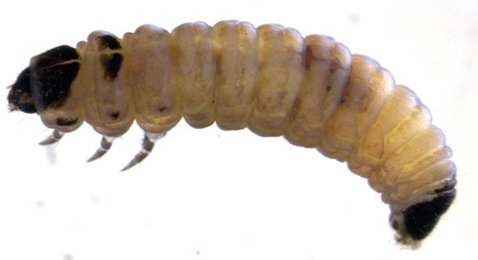|
||||||
|
STAPHYLEA. Bladdernuts. [Staphyleaceae] |
|
Two species of Staphylea are recorded in Britain. Both are introduced. Two British miners are recorded on Staphylea. A key to the European miners recorded on Staphylea is provided in Bladmineerders van Europa. |
|
Key for the identification of the known mines of British |
1a > Leaf-miner and case-bearer: The larva feeds on a wide range of trees, shrubs and herbs, favouring Rosaceae, but not exclusively. The fully developed cased larva may be found active in October and again, after winter diapause, in April. Cases, about 6 mm, of diapausing larvae may be found through winter, fixed to a tree or fence post. The dorsal surface of the case is usually covered in leaf fragments, but they can sometimes be worn off almost smooth. The ventral surface is swollen at the middle and has a keel, which usually bends upwards at the posterior. The cases of C. ahenella (on Rhamnus, Frangula, Viburnum and Cornus) and C. potentillae (case less swollen, keel not bent up, resting position less prone) are very similar. Brownish lobe case that lies almost flat on the leaf, either on the upper or on the lower side. Case widest about the middle. Ventrally there is a distinct keel. Mouth angle 0°. Full depth mines rather large. The flaps of cuticular tissue that serve to enlarge the case are cut out of the upper epidermis. (contrary to C. ahenella and C. potentillae, that use tissue from the lower epidermis). The removal of these tissue flaps creates holes that are much larger than those that serve as the entrance to the mine. |
 Coleophora violacea larva, lateral Image: © Willem Ellis (Bladmineerders van Europa) |
|
Coleophora violaceae (Ström 1783) [Lepidoptera: Coleophoridae]. |
1b > Leaf-miner: The larvae form galleries along the edge of the leaf, leading to the development of large blotches on the leaf margin. Oviposition on the leaf underside. There begins a full depth corridor that gradually widens into an irregular elliptic blotch. Generally the corridor part for a large stretch follows the leaf margin. If oviposition occurred well away from the leaf margin, the corridor starts by making some irregular loops around the oviposition site; however, when, as often occurs, the egg is placed close to the leaf margin, at once the leaf margin is mined. Frass blackish brown (rarely brown) in the corridor, black in the blotch. In the corridor the frass lies in lumps or indistinct coils; in the blotch the frass is irregularly dispersed. Pupation outside the mine; exit slit in the upper epidermis, contrary to Bohemannia pulverosella, with which atricollis may co-occur on Apple. |
|
Ectoedemia atricollis (Stainton, 1857) [Lepidoptera: Nepticulidae]. |
| Last updated 07-Jul-2019 Brian Pitkin | ||
